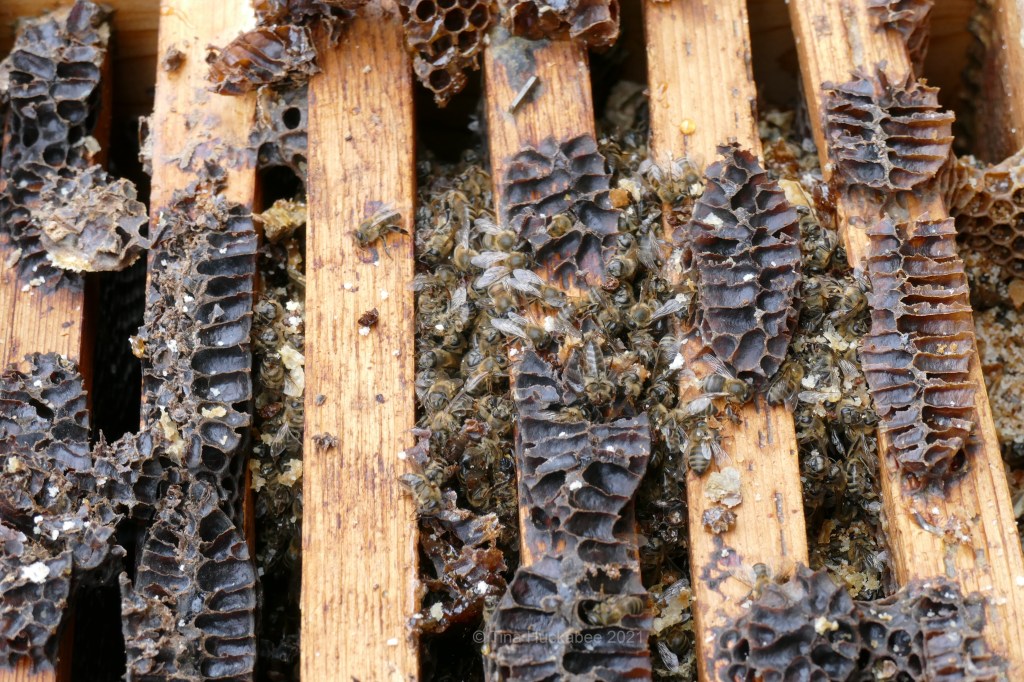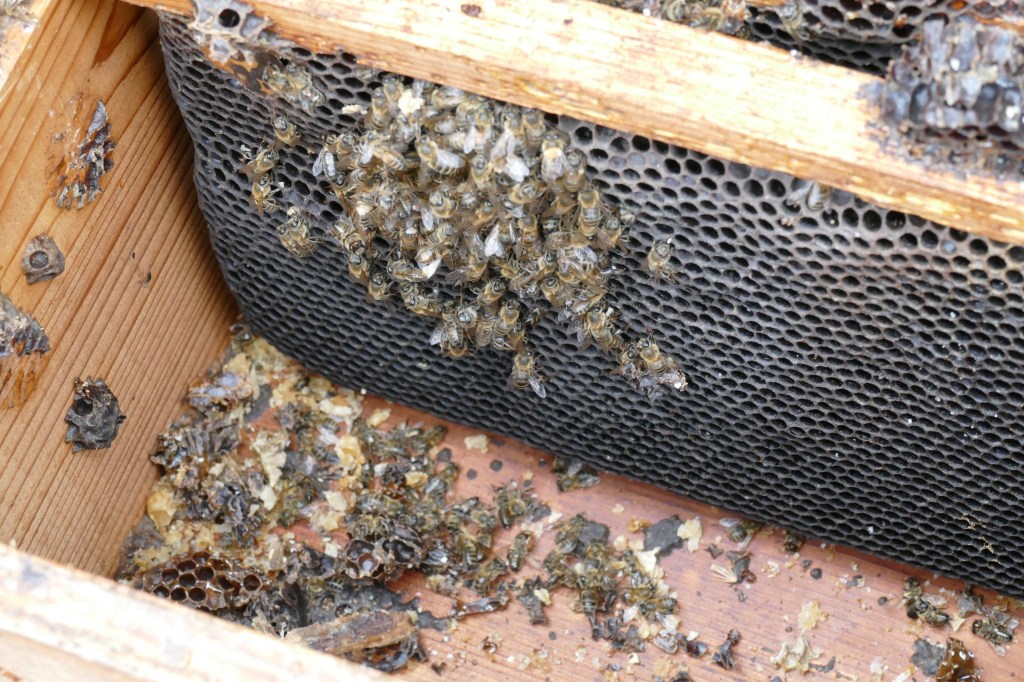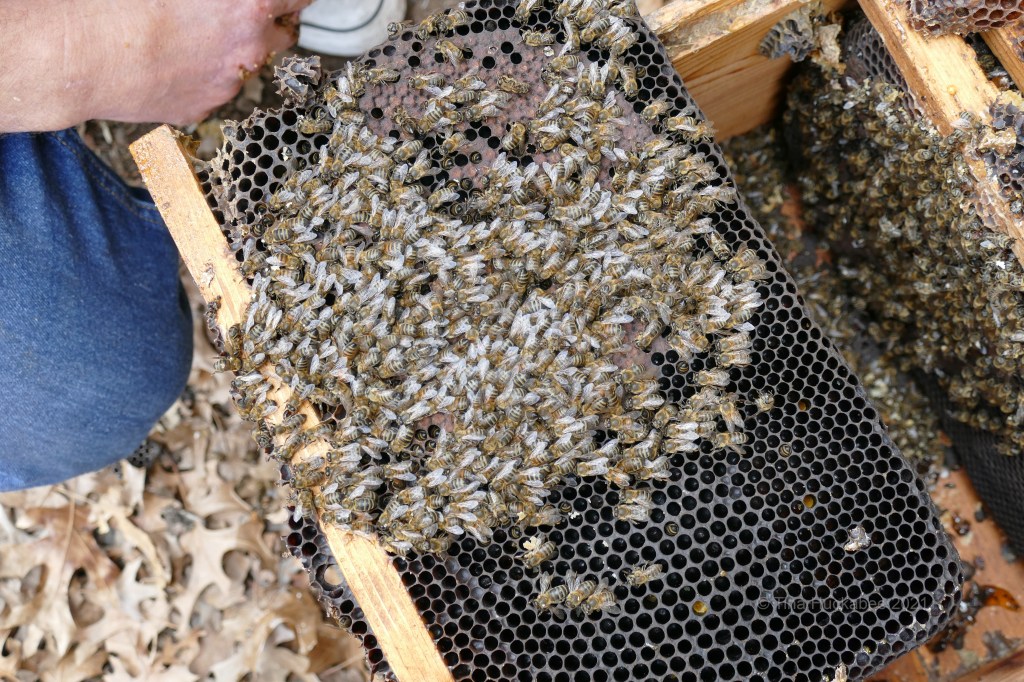Bee Daddy and I have hosted honeybees in our garden since April 2014. Our first two hives, the Warre hives Scar and Mufasa, provided sweet honey, pollinator entertainment, and a foundation of education about honeybees’ life cycles and quirky bee habits. I should add that honeybee education is on-going; those critters always present new and interesting issues which challenge their human colleagues. We lost Mufasa to a varroa mite infestation in December 2015, which you can read about here.
Scar continued honeybee life with little interference from its human admirers. The Warre hives were always difficult to maintenance, so we mostly let Scar be. If it was honey-bound, we’d take some to open up space for the bees to continue their obsessive honey-making, but otherwise we left it alone and busy with its bee goings-on.
In autumn I recognized that Scar was declining and I figured that if we enjoyed a typically mild winter, Scar would either rebound in spring, or not. What I didn’t expect was the week-long freeze, accompanied by a half-foot of snow with attending ice, and a couple of nights single-digit temperatures–snowpocalypse.
Poor Scar. It was so weak and had so few bees to keep itself warm, that during the frigid temperatures the remaining bees froze.

When we opened our two hives for the first check of the season a few weeks ago, all of Scar’s honeybees were dead. Huddled in between frames, clustered together on honeycomb, and dropped to the bottom of the hive–all of Scar’s bees were dead.


As sad as the sight was, for both Bee Daddy and myself, the most poignant was the clusters of adult honeybees over the brood, some capped, some uncapped. Even in their last moments, they were protecting the next generation.

In the photo below and toward the bottom right, you can see some bees with their faces at the opening of the cell. Those are emerging, newly adult bees. The rest of the reddish covering on the honeycomb cells are capped brood.

In this photo you can see adult nurse bees, bums up and visible, as they nurture the larvae in the individual cells. Looking carefully, you’ll notice milky coloring in some of the cells. Several show just a dab of milky coloring, while in others, the milky bit is more pronounced. Those are honeybee larvae.

We’ve taken what little honey there was, only netting about two quarts. With Warre hives, we must crush the comb for the honey to drip and it’s impossible to get all the honey. We have four containers with crushed comb and honey which we’ll lay out for the bees at a later date, when there is a dearth of blooms. The bees from our other hive(s) will slurp the honey, creating their own with it, and continue their hives’ lives.
We’ll remember Scar as a remarkably sweet little hive of bees. We almost (almost!) didn’t need smoke to calm them, they were so easy to work around.

Our remaining Langstroth hive, Woody, is full-to-bursting and very active. We’ll soon remove some frames of honey, as they had so much left over after winter. Woody is so full, I expect a swarm at some point and that’s normal spring behavior and just fine: more bees out in the world! In late April we’ll also be getting another “package” of honeybees, a queen and 10,000 workers, thus bringing us back to our two-hives standard.
Just like everything else, death is a part of beekeeping. It’s always sad to lose a hive, but it is part of beekeeping and part of gardening.

This was indeed a safe read. But thank you for it, as it provided an education. Even to the end your bees gave us a ‘teachable moment’.
LikeLike
You’re welcome, Kamala and it’s certainly accurate to say that the bees provide many teachable moments!
LikeLike
Rather sad but I guess that’s life, and you have some newbies (see what I did there) on the way hopefully these will not need smoking either.
LikeLiked by 1 person
Yes, it is sad and yes, I see what you did there. 🙂
LikeLike
I’m sorry to hear about your hive. This freeze was something else. I still have lots of bees drinking my hummer sugar water. Where do you think they live? In a hollow tree?
LikeLike
“Something else” is an understatement. 🙂 Your visiting bees might live in a tree hole somewhere close by (very likely) or maybe you have a neighbor who keeps bees?
LikeLiked by 1 person
Tina I remember when you lost Mufasa, it was a shame. Scar would have survived if the wave of polar cold, snow and ice that partially covered her had not come. Scar’s poor bees have all frozen to death covering her young. How sad, I am very sorry, it has been a great misfortune. Luckily you have been able to get honey for other bees to feed as there are almost no flowers and Woody. I am very happy that Woody is healthy and full of bees: that he soon forms a swarm and more bees to Nature, which has lost many. I really like that you are planning to bring Scar back to life with a pack of honey bees, a queen and 10,000 workers – I love it. Tina has been a sad but very instructive blog, I really liked it, thanks for writing it. Tina, Bee Daddy and you take good care of each other and stay safe. Best wishes to both of you. Very affectionate greetings from Margarita.
LikeLike
Thanks, Margarita–it was a sad post and I was very sorry to lose Scar. But it’s life in the garden and life with bees! You take good care, too! Hope your spring is very nice.
LikeLike
So why is it that Woody not only survived but is thriving?
You won’t be surprised that “hives’ lives” caught my attention. In a colony of bees I guess you never get to rhyme with “wives,” as there’s only one queen.
LikeLike
Woody was a robust hive before winter, strong queen, lots of workers. Scar is an older hive and while the queen was clearly still laying, the population had dwindled to maybe only a thousand bees. That just wasn’t enough to keep them warm in the freeze.
LikeLike
Thanks Tina for this interesting insight into the life of bees. They are such amazing creatures and are so undervalued, I don’t think people in general understand just how important bees are to us. I felt so sad reading how in the big freeze you had the bees continued doing their work right up until their last moment, such dedication is much admired.
LikeLike
Sue, I think that’s what struck us so much: that even as they were freezing, they were doing their jobs in feeding and protecting the young. I’m sure that if I’d been inclined to sift through the pile of dead bees (I wasn’t), I’d have found the queen completely surrounded by the workers. It is admirable and the harsh temperatures were tragic.
LikeLiked by 1 person
Always sad to lose a hive, but as you indicated, it is the Circle of Life– you named your hives appropriately!
LikeLike
Yes, and I knew that Scar was declining, so it wasn’t a surprise when I suspected and then discovered its death. I think our new hive will be named Bo-Peep. She’ll keep Woody company. 🙂
LikeLiked by 1 person
Like me, you must be a Disney fan. 🙂 Do you have a favorite?
LikeLike
It would probably be more accurate to say I’m a Pixar fan, but hmmm, favorite. I love “Coco”, “Up”, “Monsters, Inc”. But the whole “Toy Story” trilogy is also sweet. Good memories of watching at least some of these with my children and I like them, too! We subscribed to Disney+ in recent months to watch “The Mandalorian” but all of the Disney/Pixar animated films are there, including the shorts, which are great. All a nice break from the real world.
LikeLike
When I was out at the San Bernard refuge, I found one bee that clearly was in distress. It was weak, and having a hard time walking up a grass blade. I’ve found single bees dead on boats from time to time, and my assumption is that they simply have reached the natural end of their life. The one at the refuge I don’t know about. It was sad to see, and even though I took some photos of it in extremis, I couldn’t bring myself even to save the photos.
I hate that you lost your hive, and it’s touching beyond words to know that they tried their best to cope with the cold. I did see that on a local FM road there suddenly are dozens of new hives in a field. Whether they’ve been brought in to pollinate, or someone’s taken up bee-keeping I don’t know, but I smiled when I saw them. Life goes on!
LikeLike
Life does go on and that’s a good thing. I imagine that the lone bee you saw was just as you suspected, at the end of its life. I see mine all the time in the garden; they don’t walk well, stumbling here and there, falling off of bits of mulch or low growing plants. It’s sad to see, but they live very important lives, so good for them!!
LikeLiked by 1 person
Perhaps you two will have a heart-warming little smile at this: https://www.reddit.com/r/MadeMeSmile/comments/m9sw8o/gretel/?utm_source=share&utm_medium=mweb
LikeLike
A spider named Gretel–that there is a children’s book! Thanks for the clip, so sweet.
LikeLike
This is so sad! Honeybees had been a problem for us, as they inhabit some of the old buildings here. They returned to the same building three times (twice after the primary removal)! We could not figure that out. The beekeeper who removes them for us assures us that they go to good homes. Guests who witness the removal are so concerned about them.
LikeLike
It is sad, Tony, but it’s part of nature and the impacts of weather and conditions.
I imagine your bees come back because of the pheromones–that’s how they communicate and that chemical connection is a strong one.
LikeLiked by 1 person
I suspect the same. It is more than coincidence.
LikeLiked by 1 person
What good-hearted little loves. 💚
LikeLike
Yes!!
LikeLiked by 1 person
Sorry that the cold finished Scar in such a decisive way. It can’t have been easy to open the hive to such a tragic sight. Glad your other hive is thriving. Long may it continue!
LikeLike
It was a painful hive check, that’s for sure. We’ll get back into Woody this week, but she seems totally revved up for spring!
LikeLike
Pingback: Au revoir, Woody | My Gardener Says…